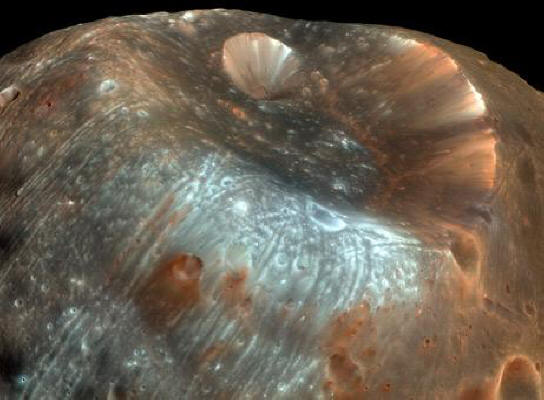
home •
about •
essential guide •
picture of the day •
thunderblogs •
news •
multimedia •
predictions •
products •
get involved •
contact
picture of the day archive subject index
HiRISE image of Stickney Crater on Phobos. Credit: NASA/JPL/University of Arizona.
Apr 14, 2008
Is Stickney Crater an Impact Feature?
Stickney crater is almost half the diameter of Phobos itself. Why did the impact not shatter this small moon?The color picture above is a composite from two pictures taken about 10 minutes apart in order to give the 3-dimensional aspect. A recent Picture of the Day described some of the large-scale formations on Phobos, especially Stickney Crater, but this more dramatic picture, which has recently become available, deserves another showing because it portrays the distinctive features of an Electric Discharge Machining (EDM) event with greater clarity.
The smaller, later craters on the rim deserve special attention. This is the pattern that one would expect to see in a discharge event, since the initial strike from the plasma bolt would be the most energetic and later, smaller discharges would preferentially strike the higher feature—the rim. The clean machining of the crater part way up on the inside of the rim is another distinguishing mark of EDM. How can this feature be part of an impact?
Images of Phobos reveal prominent streaks and grooves, some of which are running up and over the rim of Stickney Crater. These also are features expected from this kind of EDM event. Some of them are in directions that are not radial and some have course changes, which leads to the question: “Would these two phenomena ever be expected in an impact event?”
As to the streaks and grooves, The Astronomy Picture of the Day for April 08, 2008, says, ” Even though the surface gravity of asteroid-like Phobos is less than 1/1000th Earth's gravity, streaks suggest loose material has slid down inside the crater walls over time…. The origin of the curious grooves along the surface is mysterious but may be related to the crater-forming impact.”
But the same question remains: “Is this the sign of an impact event?”
Rather than being indicative of a meteor crashing into the surface, the many other pits and small craters that dot the landscape are to be expected in an EDM event. In the scenario of interplanetary discharges envisioned in the Electric Universe hypothesis, Phobos could hardly have escaped being caught in the crossfire. Stickney Crater mirrors those on other comparably sized asteroids such as Eros and Mathilde, as well as the moons Mimas and Tethys.
Contributed by Michael Armstrong
___________________________________________________________________________
Please visit our Forum
The Electric Sky and The Electric Universe available now!

|
|

|
EXECUTIVE EDITORS:
David Talbott, Wallace Thornhill
MANAGING EDITORS:
Steve Smith, Mel Acheson
CONTRIBUTING EDITORS: Michael Armstrong, Dwardu Cardona,
Ev Cochrane,
C.J. Ransom, Don Scott, Rens van der Sluijs, Ian Tresman
WEBMASTER: Brian Talbott
Copyright 2007: thunderbolts.info
![]()
home •
thunderblogs •
forum •
picture of the day •
resources •
team •
updates •
contact us

